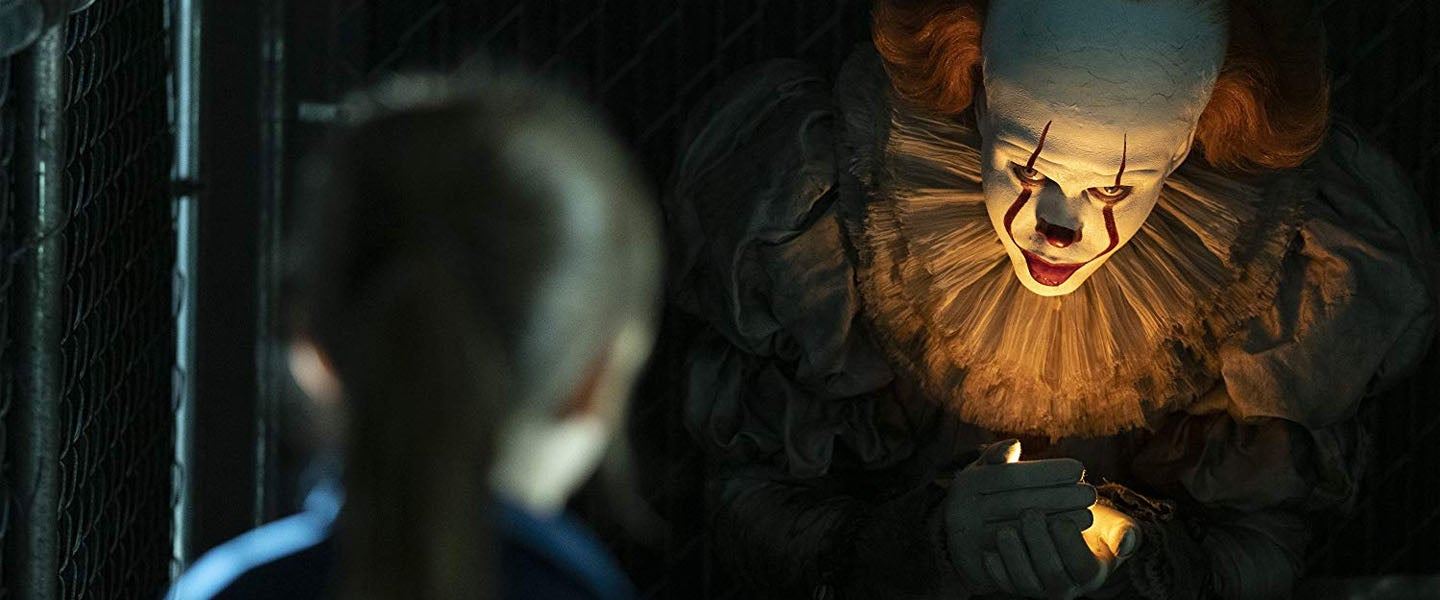Pennywise might be a child-chomping clown, but in IT Chapter Two, nostalgia is his bait. He knows that the past can prove to be a dangerous lie that can serve as an effective trap. And so, when the film’s latest installment gets to the good stuff — a second act of consistently scary scenes — it’s him fucking with the now-adult members of the Losers’ Club at the places most important to them, sneak-attacking them with the terrifying memories they’ve long since repressed. For example, Richie (Bill Hader, doing a sterling impression of Finn Wolfhard), returns to the movie-theater arcade where he spent some of his happiest days as a kid, but is confronted with a nightmare he’s forgotten since leaving Derry — being bullied for his already repressed homosexuality, something Pennywise viciously makes him revisit. Whatever mistruths Richie has told himself about his time in Derry since leaving the small Maine town, he now has to accept that they’re all lies in order to live.
More largely, IT Chapter Two is about how part of getting older is accepting that some things sucked more than we care to remember — maybe we sucked a little, too — and that’s perfectly okay. Otherwise, nostalgia remains dangerous, causing us to lie to ourselves about where we’ve really come from, and when that’s taken advantage of, reality can be that much harder to face.
Ironically, of course, IT Chapter Two is a sequel, an adaptation of a book and a project that was definitely inspired by the original 1990 TV miniseries, starring Tim Curry as Pennywise. Basically then, its existence is part of a nostalgia for a previous source. Yet the film doesn’t have the same sense of comfort as 2017’s It — this one takes place in the harsh daylight of the present and without the wistful, Spielbergian vibe of the first movie. The innocence of the characters is gone, not because they’re no longer kids, but because they’ve been in denial of their true past selves, making some confrontational therapy by a homicidal clown almost a good thing.
It’s also obviously part of a larger Hollywood trend of heavily trading on nostalgia (and maybe nothing else?) at the box office, coming on the heels of numerous high-profile, summer nostalgia plays. There were Disney’s remakes of The Lion King and Aladdin, two pointlessness, curdled exercises in attempting to recreate a past that no longer exists. And one of the most popular shows on TV is wrapped completely in the 1980s — Stranger Things. So much so that its product placement has gone IRL, with Coca-Cola putting its previously failed product, “New Coke,” back on shelves just because the show had revisited it in its endless “Remember this?” aesthetic. Netflix has said it didn’t make money by collaborating with Coke, but the product placement nonetheless worked to get the name Stranger Things even more out into public, as if it were a blockbuster movie… from the 1980s.
That’s not to say nostalgia can’t be done well. Quentin Tarantino’s Once Upon a Time in Hollywood might have been all about the state of (duh!) Hollywood in 1969, but it’s the sense of originality that he offers as he plops us into the front seat between Brad Pitt and Leonardo DiCaprio that makes things feel exclusive and special. And as much as the film is amazed by the era it’s set in, it’s also infused with a sense of longing that feels very much aware of 2019 — i.e., it wasn’t pretending like this type of movie should exist today, it was mourning that, with the waning days of theatrical releases, it will be the last of its kind.
I get the appeal of nostalgia when it comes to comfort — anything is better than the ugliness of the past (or today for that matter) — but to quote my favorite phrase from my favorite Pulitzer Prize-winning book, Philip Roth’s American Pastoral: “It’s nostalgia. It’s bullshit.” Which brings me back to Pennywise. His terror in IT Chapter Two reminds us that nostalgia is completely seductive bullshit, as it doesn’t provide a full escape so much as a cheap, fleeting sensation, denying the parts of ourselves that need addressing and leading to mere copies of products that came before us. Bad memories and original ideas — that’s what we shouldn’t be afraid of.
Here are three other takeaways from IT Chapter Two…
#1. A Three-Hour Runtime? No Problem.
IT Chapter Two must hold some kind of record for runtime when it comes to horror films released by a major studio. And while I was prepared to be a hater at that bewildering, excessive choice, I had too much fun overall with the film and its Jack-in-the-Box scares to really notice. Even the sequence where Beverly comes home — which is used like a short film to kick off the theatrical trailer — made me jump.
Moreover, once the story re-acclimates us to the members of the Losers’ Club, it gives each of them a scare sequence, and for the most part (and no matter their length), they’re a lot of fun, thanks to some great special effects and director Andy Muschietti’s droll sense of humor. The only time the film’s length felt obvious was the final showdown with Pennywise, which was true of the miniseries, too.
Paired with a recent screening of Midsommar: The Director’s Cut, (two hours and 50 minutes), I’d say there’s more to be done with long runtimes, though it does help to know where the movie is going. (I couldn’t get enough of Midsommar, in large part because the movie had given me so much time to get caught up in it.)
The coup de grâce of epic runtimes, however, will be Martin Scorsese’s upcoming The Irishman, which is three and a half hours long. But again, I’m totally fine with it. For two reasons: 1) You have to trust a filmmaker like Scorsese; and 2) it maximizes the likelihood that future Best Supporting Actor nominee Action Bronson made the final cut (after all, he’s already rapped about it).
#2. What Did We Do to Deserve This Resurgence of Scary Clowns?
First, there’s Bill Skarsgård, who is a true upgrade from Curry’s curmudgeonly child abuser that many revere from the miniseries. Skarsgård is an essential part of the dread of this story, including any time that he has a dead stare at a kid or whenever he draws out his vowels. The movie even gives him another gratuitous kill (poor Veronica) because he’s so good. There hasn’t been enough praise for the work that he does with Pennywise, which in my mind, is similar to what Heath Ledger did with the Joker in The Dark Knight. Skarsgård is an emotionally grounded bastion of fear who is terrifying with or without the special effects he’s treated with.
But good god, if you want a clown who’s even less playful and more vicious than Pennywise, I suggest you meet Art the Clown, created by writer/director Damien Leone. He’s the main villain in the disturbing 2013 triptych All Hallows’ Eve and its 2017 followup Terrifier, a bloodthirsty incarnation of chaos who seeks to create carnage in a way that verges upon the experimental.
Leone is so committed to making Art scary that he practically excises narrative in both cases — Art doesn’t exist in a world like Jason Voorhees or Freddy Krueger, where we meet his targets for about half of the film’s runtime before the killing starts. Nope, these movies are relentless with their violence, and are backed up by Leone’s considerable SFX skills. There’s some disgusting, truly scary shit in both of them, and if you didn’t already have coulrophobia — that is, a fear of clowns — they will swiftly change that.
#3. Is That the Guy From the Old Spice Commercials? Hell Yeah It Is
A lot of praise for the acting in IT Chapter Two is going to be aimed at Bill Hader, who reminds people yet again that he can strike the perfect balance of sharp and emotional.
But the real hero of IT Chapter Two is Isaiah Mustafa. You probably recognize him as the Old Spice Guy, where he’s displayed great comic timing while getting you to think about body wash. But his much more neurotic work as Mike Hanlon, the only one who stayed in Derry (and therefore, sees things completely differently), has a strong emotional undercurrent and is essential to the story’s drama.
So here’s hoping that we see a lot more from Mustafa in the future — with or without his shirt on.

